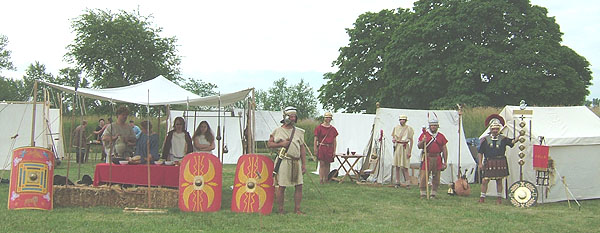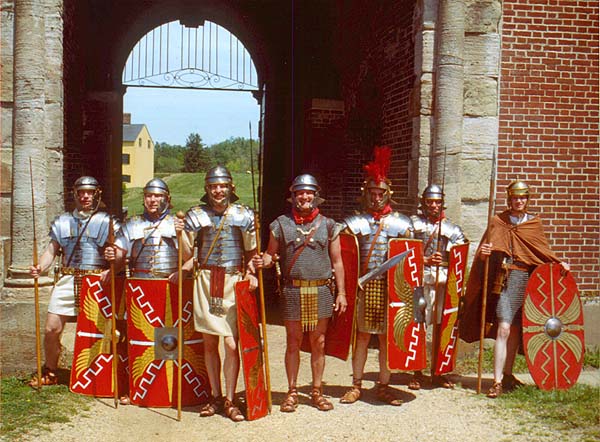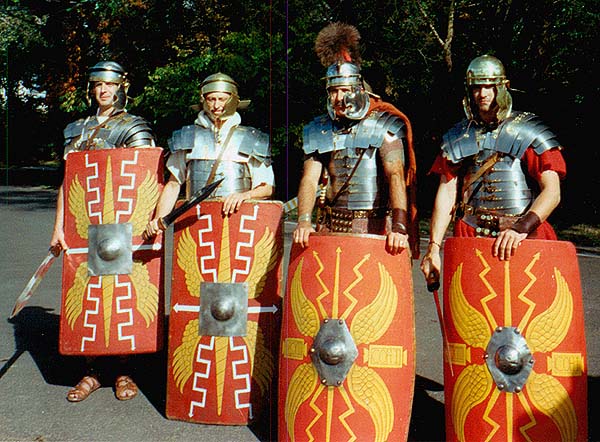Legio XXIV Media Atlantia (Nova Roma)
LEGION XXIV MEDIA ATLANTIA
Gallio Velius Marsallas / George Metz
Praefectus - Commander
Tribunus Militaris
13 Post Run - Newtown Square PA 19073-3014
legionxxiv@comcast.net http://www.legionxxiv.org
610-353-4982
Salve et Salutationes - Hello and Greetings:
Commiliton - Military Comrade and Fellow Citizen:
Thank You for inquiring of Legion XXIV Media Atlantia.
Contact us at legionxxiv@comcast.net and we will add you to our e-mail list to receive our "Vicesima Quarta" newsletter.
Legion XXIV Media Atlantia is one of the premier units reenacting the military tactics and life of the soldiers and legions of Republican and Imperial Rome. Our Legion is probably the only historically accurate unit in the United States capable of fielding three artillary pieces - two Cataputae and an Onager, each of which cast an arrow-bolt or projectile 200 to 300 feet. See them at [1]
Other pages of interest could be:
- Alphabetic Site Index at http://www.legionxxiv.org/index
- Equipment at http://www.legionxxiv.org/equipment
- Armor at http://www.legionxxiv.org/loricapage
- Weapons at http://www.legionxxiv.org/weapons
- Past and Future Campaigns at http://www.legionxxiv.org/events
- Photo Gallery at http://www.legionxxiv.org/cmndertimewarp
Those less than 18 years of age must have their parent's permission to affiliate with the Legion. Minors are not permitted to handle weapons without supervision. Sorry, but with today's legal situations, we must be careful about this.
Contents |
Origin and Purpose
Legion XXIV Media Atlantia was established in 1997, as a "not-for-profit" educational organization to display the appearance and reenact the activities, military tactics and lifestyle of the ancient Roman Legionary Soldier of the First Century AD; as well as other periods of ancient military history.
Sponsorship of Legio XXIV Media Atlantia was approved by Senatus Consultum, a.d. XVI Kal. Apr. ‡ Fl. Vedio M. Cassio cos. ‡ MMDCCLI a.u.c.
The Mid to Late First Century AD era of the Roman Empire is the primary time period represented by Legion XXIV MA during our re-enactment events. However, as we are interested in portraying a wider period of ancient military armor, dress and style in a "Military Through the Ages" format; Republican Romans, Sumerians, Spartans, Macedonians, Greeks, Celts, Barbarians and other ancient military personnel, along with those just interested in ancient military history are also most welcome.
The campaigns of the Legion are conducted in the Mid-Atlantic Region of PA, MD, VA, NJ, NY, CT, MA and ME. We also defend the frontiers of Ancient Rome in Ohio and Western Ontario. Most of the campaigns are so-called "Time-Line" events, where a number of organizations are in attendance representing periods of history from Ancient Rome to WW-II and Vietnam.
The Legion strives for historical accuracy in its presentations and appearance. However, as there is a dearth of historical evidence to draw upon, our presentations are generic in nature and are stated as being accurate to best of our knowledge and belief. All clothing and equipment should be as authentic as the modern world allows, tempered with practicality; such as, fabric does not have to be hand-woven, armor is made of mild-steel rather than hand-forged iron. Although Roman military reenactment is not a cheap hobby, it is probably less expensive than "Rev-War" or "Civ-War". At least there are no costly firearms, ammo and pricey uniforms to buy.
Not everyone has to be a legionary soldier, and certainly not all at once. Rome was a bureaucracy. There were a whole slew of support "staff" that followed the armies around: scribes, accountants, cooks, coopers, doctors, medics, metalsmiths, leather workers, teachers, servants, slaves, and others. You may want to develop a "civilian" impression and start off small. You might actually find it more interesting than doing the army gig. Those under 18 could serve as medics, servants or squires with just a tunic, belt and caligae or be a scribe to follow the commander around taking dictation with just a tunic, some quills, parchment paper, and a wax tablet with a stylus.
Adopting a civilian impression, while working towards a soldiers kit, will add depth and character to the unit as well as hopefully drawing more people into the hobby by demonstrating to the public a larger portion of the glory that was Rome.
Suppliers
Do not purchase any items from Museum Replicas. Their products have many general inaccuracies and are not normally acceptable for use in Legion XXIV, nor in many other reenactment legions as well. Items from Deepeeka of India are generally acceptable and are a good value for the money spent. Deepeeka items are widely available and can be normally obtained within a couple of weeks. Custom armorers provide the best and most accurate equipment at higher cost and waiting times of up to two years. Expect to pay up to $1000 to acquire most of the equipment needed to be fully outfitted. Some items such as tunics, caligae (sandals), scuta (shields), cloaks and other cloth and leather items can be made by the members. Lorica segmentata plate armor can also be self-made, if you have decent mechanical skills. Helmets and swords must be purchased, as these items require hot-forging to be properly made. For Things to Avoid go to http://www.larp.com/legioxx/bad.html for an excellent list and photos of items we do not sanction or permit for use in Legion XXIV. Consult www.legionxxiv.org/supplierlinks for the suppliers endorsed or recommended for acquiring armor, weapons, clothing and other necessary items for taking part in our campaigns and activities. Consult with the Commander before spending any large amount on equipment. Don't find out at your first event that your new helmet, armor, sword or other gear does not measure up to standards. This happened to the Commander and it smarts!
Adopting and using a Roman name
Since Legion XXIV MA endeavors to portray an accurate interpretation of Roman Military Life; it is requested that you choose a "Roman Name", when you enlist with the "Legion". The use of Roman Names by the Legion's participants will foster a more authentic ambience and realistic atmosphere during our public appearances. When the Legion is on public display, its members are no longer living in the 20th Century; but are representing an encampment of ancient Roman Army soldiers. Using your chosen Roman Name will help in removing yourself from the current (mundane) modern time period and assist you in "getting into character" and obtaining the proper "frame of mind" as a Roman Legionary.
If you've already chosen a Roman name for yourself, advise the Commander when you "sign-up". If you are new to Roman culture, and would like assistance in choosing a Roman name that expresses both you and your interests, consult the Roman Names Page of the Website or contact the Commander at legionxxiv@comcast.net It is not necessary to choose a historical name; often people will take elements from several historical names for their own. They may also consider a name of where they were born or raised (i.e., Candidianus, Cincinnatus, Columbanus, Philadelphus); or a name relating to their heritage (i.e., Germanicus, Germanus, Hispanus, Italicus). The Roman name you assume will be entered into the membership rolls of the Legion, along with your "given" name. Your Roman Name will be used when contacting you, and we urge you to make your reenactment experience a more authentic one by making use of it in your reenactment correspondence and public participation, as well as during informal conversation when we are together within the encampment. In everyday use, people are referred to by either a combination of the praenomen and nomen or the praenomen alone; or even more usually by just their cognomen. So, "Gallio Velius Marsallas" could be addressed as either just "Marsallas" or "Gallio Velius" or more casually by just his praenomen of "Gallio". "Cordelia Alia Julia" would be either just "Julia" or "Cordelia Alia" or just "Cordelia".
Rules and Guidelines
The following rules and guidelines should be observed.
During periods of public display; or when the public is in the area of our camp; "The Legion is on Parade" and is being judged by the public! Our historical appearance and impression must be properly maintained. You are no longer living in the 20th Century - You are then a Legionary of Legion XXIV MA in ancient Rome. Inappropriate language and/or discussions, actions and conduct within sight or earshot of the public must be avoided! "Out-of-Character" items such as: eyeglasses, wristwatches, non-period finger rings and earrings, modern jewelry or other inappropriate hairstyles or visible body decorations are not permitted during public hours. The use of contact lenses is recommended. Proper headgear could mask a non-historical hairstyle.
Clothing
Linen or Wool, must be 100%, no blends, polyester or substitutes. Twills were common. Cotton or silk for civilians only. All exposed stitching, hems, etc; should be done by hand.
Civilian Clothing
Leather
Vegetable tanned, top grain. Avoid leather splits, suede and chrome-tanned leathers. Goatskin and calfskin were common. May be dyed and should be treated with wax or neat's-foot oil for protection from weather and body sweat.
Armor and Metal
Use mild steel. Stainless steel or galvanized steel is inappropriate, as are pop rivets, split rivets or tubular rivets. Brass may used for bronze items. Brass items may be tinned.
Wood
Ash is best for weapon shafts and tool handles. Plywood is used for shields. Exotic woods like ebony and mahogany should be avoided, unless provable. Exposed modern bolts, hex-nuts and screws should be camouflaged to appear less modern, such as filling screw slots with solder and filing smooth, etc.
Experienced reenactors can find flaws in most everything that we wear and use and we understand that perfection is impossible. A reproduction is good enough if it can be examined by a knowledgeable person without finding any obvious errors or anachronisms. A good reenactor should strive for the highest possible level of authenticity.
Kit
The "kit" ( a soldier’s clothing, weapons, gear and equipment ) required for participation as a legionary at public events would be as follows. . .
Basic Kit
Basic kit ( the minimum required to "turn-out" for public events ) is: Tunica (Tunic), Caligae (footwear), a basic waist tie for blousing tunica above the knee, Fibulae (antique pin broach) for pinning tunica to proper fit; along with whatever personal items you may require.
Standard Kit
Standard Kit (required for full participation): The Basic Kit plus:
- Helmet,
- Armor (Lorica Segmentata or Hamata),
- Gladius (short sword),
- Gladius Baldric (shoulder belt),
- Pilum (javelin),
- Cingulum (waist belt with apron dags),
- Subarmalis ( garment worn under armor for comfort),
- Focale (neck scarf),
- Satchel (marching pack bag),
- Paenula or Sagam (cape/cloak).
Full Kit
Full kit ( desired ) Standard Kit plus Pugio (dagger), Helmet Crest, Bracia (trousers), Galea (leather helmet), Patera (food plate), Tools and Mess Gear, Carry Pole for Satchel, Pila Muralis (palisade stakes), Lodixicis (dark red or brown blanket).For chilly weather events you will want to add home-made woolen leggings and socks, along with a wool cloak or cape. As a wool cape or blanket is naturally rain repellent; it could be handy as an emergency cover for keeping your helmet and armor from getting too wet during rain showers, which our events seem to attract with regularity.
Commercial store bought trousers, socks or other clothing items are not appropriate and would be "out of character" with the historical appearance we endeavor to present.
Consult the "Equipment", "Weapons" and "Glossary" Pages of the Website for more detailed descriptions of the various items of equipment.
Looking forward to having you with us on our future campaigns defending the modern frontiers of Ancient Rome, I remain;
In Vires et Honos - In Strength and Honor
Gallio Velius Marsallas (George Metz), tribunus Praefectus / Commander - Legion XXIV Media Atlantia


